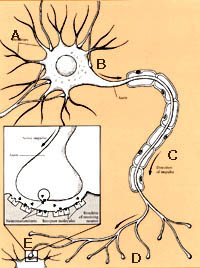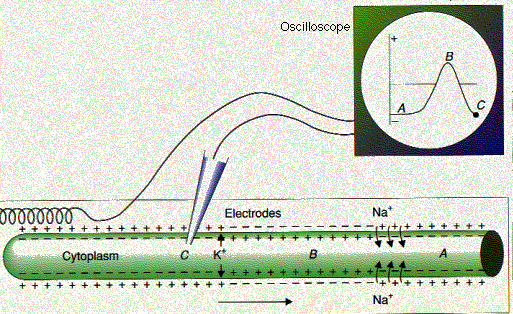Meet the Neuron: Neural Structure and Function
James KentChapter 07 : Psychedelic Information Theory Recollection
It's been about ninety minutes since I've ingested an homemade ayahuasca brew and the hallucinations are so heavy they fill the entire room. At first I only saw them with my eyes closed, but now they are there all the time. I walk around the space, trying to figure out what is going on. Light and shadow has full three-dimensional form, energy waves and magnetic fields swirl around me, everything pulsates with a seething energy just barely holding everything together under the surface. I am looking at a new reality, something just beyond my ability to comprehend, and I try to make sense of it all. I know this is all the result of tiny slices of DMT crystal resting against the fine structure of my neural membrane, in fact I see it happening in my head. The crystals tile over my receptor formations like scales, writhing and vibrating as dangling receptor macromolecules greedily cling to them. I can see it happening in my head, but it doesn't explain what I am seeing when I open my eyes. The full-spectrum transformation of reality seems too abrupt, too complete to have been caused by this one little molecule. I shake my head in disbelief, as if someone has played a trick on me. This is more complex than I thought, I think. Something weird is going on here.
Mechanics of Perception and Thought
Psychedelics are a complex subject, so it is often hard to know where to begin when trying to describe how they work. However, it is essential that we first know how the human brain works in order to get a clearer picture of how psychedelics do their thing. I know some of you out there are probably groaning right now, but yes, I am going to take you all the way through the hard fundamentals of neurobiology with an eye for the relevant bits you'll need to know to understand psychedelic action within the perceptual framework. For some of you this material may be unnecessary, for others I'll try to make it as quick and painless as possible. All of the information that follows is widely accepted to be scientifically accurate and up to date, but it is far from a complete textbook on the workings of the brain. It is included to be a crash course for beginners or a refresher course for those of you who haven't sat in class for a while. In any case, I would urge all readers who wish to learn more about the brain to start with the books and online pointers listed at the end of this section, or to follow-up with your own research online or at you local public library. So, without further ado, let's hit the books.
Meet The Neuron
Within the wonderful sense-data processing organ we call our brain, the quantum unit of processing hardware is the neuron. If we wish to understand what is happening within our minds as we process reality (altered or not) the place to start is here. Although we will discuss specific areas of the brain throughout various parts of this book, lets just take for granted at this point that the brain consists of several task-specific, logic-processing lobes or areas or organs (also know as circuits, groups, nuclei, ganglion, clusters, or networks) which are all built from dense bundles of interconnected neurons. In order to visualize the neural net at work I would like to spend some time discussing the nature of the neuron. The material in this chapter is presented to give the reader a very brief overview in the basics of neural structure and function, which is a complex issue to say the least, but to make things easy we will be focusing primarily on the structure and function of pyramid cells in the cortex, since they are the main conduits of both sensory and motor data processing within the brain and body.
Neural Structure and Function
 |
Figure 1: Meet the neuron
All signal in the brain passes as electrochemical impulses through networks of neurons. Chemical signals first hit the neuron at receptor sites along the dendrite trees (A) and cell body (B). When a neuron's action potential is fired, the charge is moved in a pulsed wave along the axon (C) and terminal branches (D), sending a chemical signal across each synaptic connection (E) to the post-synaptic neurons along the firing chain.
[More Info] [More Images]
|
|
So here we are at the neuron. There are three main parts to your typical nerve cell: The dendrites, which can be short nubs or long branching trees, are covered with receptors which primarily receive neurotransmitters fired from preceding (pre-synaptic) neurons. The axon carries the neural charge down various long branches, each one ending in a terminal which fires transmitters across the synapse to receptors downstream (postsynaptic). And finally we have the cell body which is the center of all the action, containing the cell's nucleus. The nucleus contains the cell's DNA, which acts as a cellular blueprint and a tiny factory for RNA, proteins, enzymes, and all the intracellular machinery needed to maintain the cell, build neurotransmitters from raw materials, and move necessary chemicals around the cell.
Although we like to think of the neural net in terms of wires crackling with smooth electrical impulses, it is in reality far more complex and dynamic than a pure electrical model. Unlike wires which conduct raw electrons at close to the speed of light in a metallic (or fiber optic) medium, neurons carry their charge within an ionized (electrically charged) saline solution. Our brains (and our entire bodies) are filled with salt water - no doubt a leftover from our earliest ancestors evolving at the bottom of an ocean - and the delicate balance of charged salts floating around in our neural soup mediates all signal flow and allows our nervous system function as it does.
 |
Figure 2: The Signal Fires
As the neuron depolarizes, a cascade of charged ions pulses along the neural membrane. The polarity of charge across the neural membrane is mediated by salt ions, in the case of firing it is sodium (Na+) and potassium (K+) that are exchanged through the membrane via selectively controlled ion channels.
[More Info] [More Images]
|
|
There are hundreds of billions of neurons networked together within the brain, each one having the capacity to fire at up to 1000 times per second. Although neurons are "talking" to each other all the time, the only signal one cell can send on to the next is either "fire" or "don't fire," thus setting the duality of signal promotion and inhibition which is the basis of all neural logic circuitry. The neural firing mechanism is a swift change in electrical charge across the cell membrane (or depolarization), and this voltage differential is mediated by the flow of charged salts through pumps and ion channels in the membrane. The salts (also known as electrolytes) in the brain are in the form of single atoms of sodium (Na+), potassium (K+), and chloride (Cl-) suspended in water, each having it's own positive or negative charge. The ion channels which mediate the tidal movement of these slats through a cell's membrane can open and close selectively, which means they can be simulated to allow only one particular type of salt in and/or allow another type out. The ability of the neural membrane to block and/or accept any particular ion at any given time is referred to as selective permeability. The cell membrane is covered with these selective ion channels like pores, and the density of these pores increase around receptors, synaptic connections, and on other cellular junctions where the swift influx of a specific salt may be needed to stimulate depolarization or, conversely, keep the neuron polarized and in the resting state.
When the neuron is at rest only the potassium (K+) pores are open, keeping the cell membrane virtually impervious to other elements floating within the brain soup. There are also tiny pumps that push out roughly three sodium ions (Na+) for every two potassium ions it lets in. The flow of potassium into cell membrane causes the resting neuron to have an electrical potential of about 70 mV less (-) than the saltwater it's floating in. This is the polarized resting state. If the neuron is stimulated by a chemical messenger (say glutamate) from a neighboring neuron it will suddenly open a selective sodium channel for .8 milliseconds and allow a fresh squirt of positively charged sodium ions to wash through the cell membrane, thus slightly disrupting the internal charge. A ion channel which is activated in this way is called a ligand-gated ion channel, which means a ligand (like a neurotransmitter, or an ion, or a peptide, etc.) is responsible for opening (or closing) the gate. When hundreds of glutamate receptors on the neural membrane are stimulated all at once, a tidal wave of sodium ions washes through the cell membrane, and if enough sodium ions wash in to cause the polarity at the cell body to rise from -70 mV to around -55 mV (depolarization) then the neuron swiftly convulses, fires it's action potential, and sends a cascading chain reaction of sodium permeability down the length of it's entire cell body, firing messenger chemicals out the other side, across the synapse, and onto the next neuron we go.
The exchange of sodium and potassium ions along this permeability wave causes the polarization across the neural membrane to change from -55 mV to around 35mV and all the way back down to -75 mV (hyperpolarization) in about a millisecond. The ion channels along the axon are voltage-gated, which means they are activated by a local change in membrane voltage. This rapid wave of charged salts pulses down the neural membrane with each firing, and thus a very small electrical current moves down the length of each axon, producing the quantum action of thought. When the wave of sodium ions hits the axon terminals a spray of neurotransmitters spurts across the synapse to the dendrites waiting on the other side, and thus the signal is parsed out to associated networks for further processing. All of this happens fast enough for millions of synapses to fire in unison at any split second and allow you to render and react to 3-D space in near real time with no apparent lags. This rippling network of tidal charges within the neural soup is the very definition of the active mind at work, and an image that I would like you to hold in your mind as you consider the rest of this text.
Immediately following the neuron's abrupt firing there is a series of processes which start up to calm it back down and reset it's resting charge. Tiny ion pumps kick in to slurp up potassium ions and squirt out excess sodium ions, and reuptake pumps go to work recovering spent neurotransmitters for reuse in subsequent neural firings. The active neuron is a literal tidal zone of chaos, always getting ready to fire or in the process of firing, and the ebb and flow of voltage across the cell membrane is controlled by an intricate series of tiny mechanical pumps and salt channels.
Without wanting to labor the point I really want you to think about these working channels and pumps along the cell membrane for a minute because these tiny pieces of genetic nano-machinery are the only things which maintain the delicate electrochemical balance within every cell in our brain, and are the most rudimentary working elements which define the nature of mind. Our very thoughts, senses, and perceptions are mediated through the operation of these channels and pumps, each one having no moving parts larger than a few hundred carbon, hydrogen, and oxygen atoms chained together in very clever ways. These channels expand and contract in response to electrical and conformational stimulus from incoming neurotransmitters (size, shape, and charge) and manage to operate in unison smoothly enough to give us a near flawless picture of external reality. The fact that a neuron can do all that at upwards of 1000 times a second (heck, even 50 times a second seems rough), day and night, all the time, repairing itself when broken, forming new connections when needed, building all the raw materials to keep functioning from scratch... well, it is mind blowing, and in this case it is the mind itself which is mind-boggling.
The Tidal Rush
This ebb and flow of neural charge across neural membranes and the wash of transmission between synapses is what I like to refer to as the "tidal rush" of raw sensation, action, and thought coursing through our brains and bodies all the time, even when we sleep. Far from moving at the speed of light these neural impulses typically travel no faster than 100 meters per second, fast enough to carry an impulse from our retina to our neocortex in a matter of milliseconds, which is good enough for me. Imagine if you can, a single photon of light passing through your cornea and landing on an optic receptor (retina) in the back of your eye. In a dark-adapted eye, even a single photon of light can set off a chain reaction of neural impulses which shoot back through the optic nerve, hit the occipital lobes in the back of the head, round up through the brainstem and visual thalamus, and branch upward into various parts of the visual cortex and pre-frontal cortex for further identification and contextual processing. This is a very physical and tangible medium through which the signal is traveling, each wave rippling along like a drumbeat, each neuron beating against hundreds of others with its own rhythmic pulses, each attuned to the greater symphony of networked impulses rippling through your head.
When I think about the neuron in this way I almost envision it as an ancient sea creature, something like a tiny anemone breathing charged saltwater through its pores. The dendritic and axonal branches float in this charged pool, each neuron connecting to hundreds if not thousands of others just like it, all communicating through ripples of charged ions and spurts of transmitter chemicals, each slurping up the others juice in a chain reaction of electrochemical stimulus. Squirt, spurt, ripple, suck, pump, spurt... all the time, all day long. If it sounds a little pornographic that's because it is, but the basic bits of neural functioning rely on the mechanical passing of information through branching nano-tubes suspended in a saltwater matrix. This neuron, this simple unit of sensory processing hardware, is ancient genetic material, it has been around for at least hundreds of millions if not billions of years, and through the processes of reproduction and evolution we continue to create more elaborately networked systems of neurons every day.
It is interesting to think that given the simple matrix of saltwater and energy that a self-replicating information processing network could spontaneously emerge, and yet it did. It is also interesting to speculate that if the foundations of raw perception are so ancient and so simple, perhaps the nano-anemones that formed in the earth's primordial seas may also have had some crude form of self awareness and mind, and perhaps still do. But regardless of the exact moment when self-awareness materialized in living form, it was the neural structure that made it possible, and evolution has done everything it can to protect, perfect, and reproduce these complex information processing networks over the eons. The brain in your head is the product of billions of years of evolution, and every other part of your body is built to feed, protect, and replicate the unique structure of your neural logic processing circuits. The human brain is the pinnacle of evolution to date, and no doubt natural selection is doing everything it can to improve upon it.
Okay, so now we understand a little bit about the neuron. It is ancient, it is baroque in design, and fills only one basic function: to process information. As we have seen, the biological processing matrix is nothing like the smooth and uniform conduction of a copper wires, it is wet and undulating with charged pulsation, squirting and pumping the signals through our head to the tidal rhythms of life as we experience it at any given time. It is mechanical, and the mechanics are mediated by a mix of DNA, charged salts, and various neurochemicals, and even a tiny change in the balance of those salts and chemicals can have a vast change on the function of the neuron.
<< Previous | Index | Next >>
Tags : psychedelic
Rating : Teen - Drugs
Posted on: 2005-03-18 00:00:00
|




